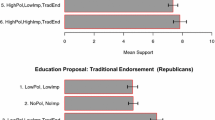Abstract
This paper examines a voter model for the US which is interconnected with the partisan theory. In our model, voters are rational and forward-looking. They are perfectly informed about the preferences of political parties and about the state of the economy. The predictions of our voter model differ from the predictions of conventional voter models, according to which the incumbent benefits from low unemployment and low inflation, irrespective of its political colour. In a partisan setting, the democratic party benefits from high unemployment and the republican party benefits from high inflation. Regressions of presidential approval rates indicate that the predictions of both the partisan voter model and the conventional model are consistent with the data.
Similar content being viewed by others
References
Alesina A (1987) Macroeconomic policy in a two-party system as a repeated game. Q J Econ 52: 651–678
Alesina A, Rosenthal H (1989) Partisan cycles in congressional elections and the macroeconomy. Am Pol Sci Rev 83: 371–398
Alesina A, Sachs J (1988) Political parties and the business cycle in the United States, 1948–1984 J Money, Credit Banking 20: 63–82
Balke NS (1991) Partisanship theory, macroeconomic outcomes and endogenous elections. South Econ J 57: 920–935
Beck N (1982) Parties, administrations, and American macroeconomic outcomes. Am Pol Sci Rev 76: 82–93
Blanchard OJ, Summers L (1986) Hysteresis and the European unemployment problem. In: Fisher S (ed.), NBER macroeconomics annual. MIT Press, Cambridge
Blanchard OJ, Fisher S (1990) Lectures on macroeconomics. MIT Press, Cambridge
Brainard WC (1967) Uncertainty and the effectiveness of policy. Am Econ Rev 57: 411–425
Chappell HW, Keech WR (1988) The unemployment consequences of Partisan monetary policy. South Econ J 55: 107–122
Downs A (1957) An economic theory of democracy. Harper and Row, New York
Fair R (1978) The effect of economic events on votes for president. Rev Econ Stat 60: 159–173
Fiorina MP (1981) Retrospective voting in American national elections. Yale University Press, New Haven
Frey BS, Schneider F (1978) An empirical study of politico-economic interaction in the United States. Rev Econ Stat 60: 172–183
Ghosh A, Masson PR (1991) Model uncertainty, learning, and the gains from coordination. Am Econ Rev 81: 465–480
Gordon R (1976) An interpretation of the costs on the instruments in deterministic linear-quadratic control. Int Econ Rev 17: 779–781
Hibbs DA (1977) Political parties and macro-economic policy. Am Pol Sci Rev 71: 1467–1487
Kramer G (1971) Short-term fluctuations in U.S. voting behaviour, 1896–1964. Am Pol Sci Rev 65: 131–143
McCallum B (1978) The political business cycle: An empirical test. South Econ J 44: 505–515
McFadden D (1974) Conditional logit analysis of qualitative choice behavior. In: Zarembka P (ed.) Frontiers in Econometrics. New York, pp 105–142
Mueller DC (1989) Public choice II. Cambridge University Press, Cambridge
Nordhaus W (1975) The political business cycle. Rev Econ Stud 42: 169–190
Persson T, Tabellini G (1990) Macroeconomic policy, credibility and politics. Harwood Academic Publishers, Chur
Rogoff K, Sibert A (1988) Equilibrium political business cycles. Rev Econ Stud 55: 1–16
Swank OH (1993) A voter model based on the Partisan theory. Public Choice 75: 339–356
Swank OH, Hebbink E (1992) Estimation of preference weights in a model of monetary policy with multiplicative uncertainty. Discussion Paper 9216/P, Erasmus University Rotterdam
Wittman D (1977) Candidates with policy preferences: a dynamic model. J Econ Theory 14: 180–189
Wittman D (1983) Candidate motivation: a synthesis of alternative theories. Am Pol Sci Rev 77: 143–157
Author information
Authors and Affiliations
Rights and permissions
About this article
Cite this article
Swank, O.H. Rational voters in a partisanship model. Soc Choice Welfare 12, 13–27 (1995). https://doi.org/10.1007/BF00182190
Received:
Accepted:
Issue Date:
DOI: https://doi.org/10.1007/BF00182190




